Gobi gosht is a heartwarming traditional Pakistani dish that brings cauliflower to life. It's best served with a side of tangy yogurt and roti.
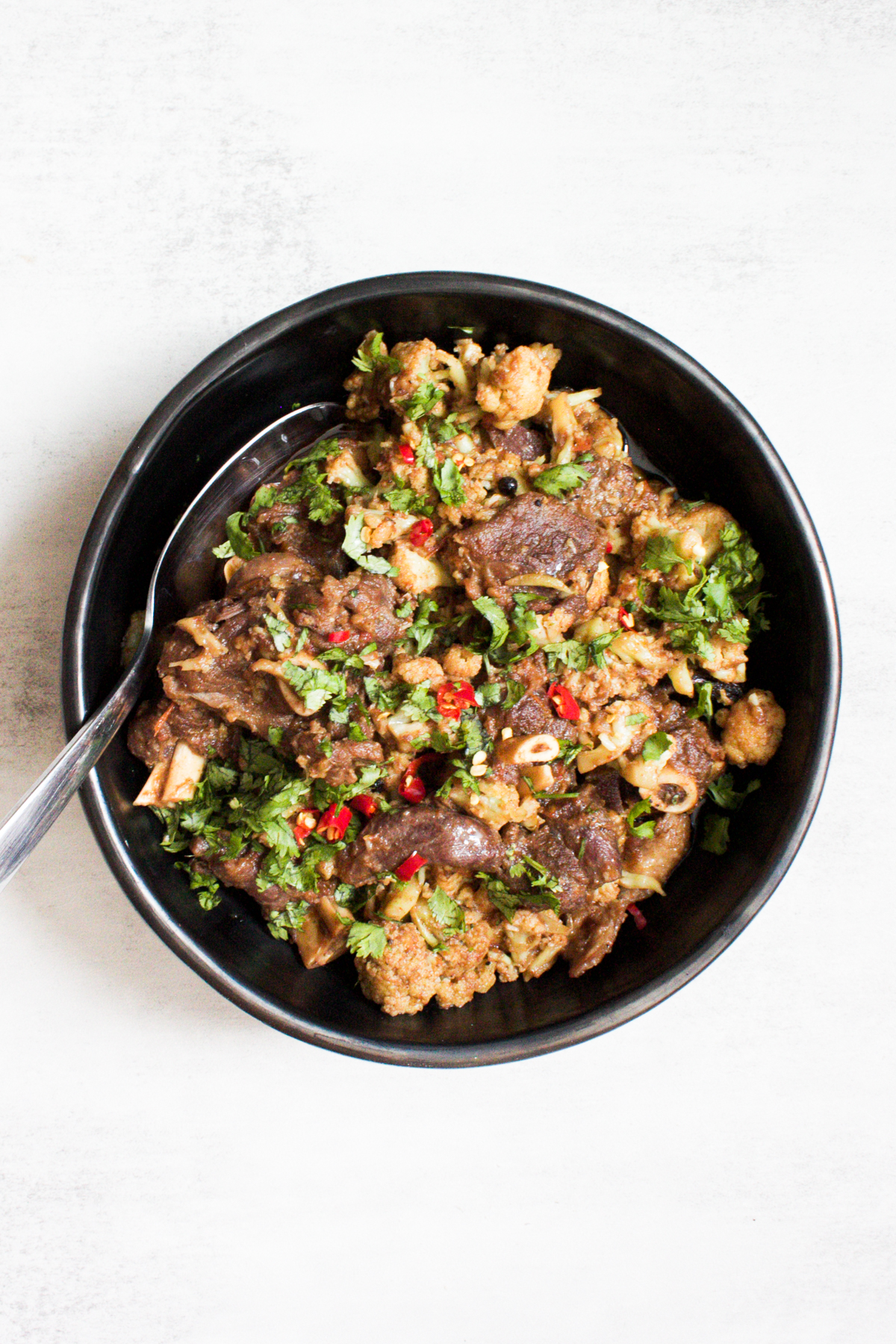
Jump to:
About this Recipe
Gobi gosht is a good example of classic desi home cooking that works quietly while you are at home, and drops off when you move overseas. So when I saw a photo of the dish pop up on my friend Mariam’s Instagram feed, I immediately asked her how to make it.
This is her mom, Bilquees's recipe. Mariam was gracious enough to digitize the recipe from her mom's notes. Bilquees's own mother is originally from Bihar, India. Although she was never able to visit her ancestral home after Partition in 1947, food was an important way of preserving her family's heritage. I recently updated the recipe for the Instant Pot, and adjusted the proportions given how much the size of produce varies in every country.
Gobi is widely used in the sub-continent. I was therefore, surprised to learn that it's only been in cultivation in the region during the last 150 years. Some claim it was introduced to the sub-continent by the British in 1822. Since then, it has become indigenized. The local South Asian variety of cauliflower is smaller than its European counterparts, and can grow in higher temperature and more humid conditions.
Personally, I have always been suspicious of gobi. Unlike in the West, South Asians don’t roast it or grind it to make faux rice like our clean-eating friends on Instagram. Instead, we fry or stew it in oil with a rich blend of spices, which makes it look a lot less pretty. As a child, I would find the texture irritating, and taste underwhelming. I would audibly groan when anybody would serve something with gobi.
Bilquees’s gobi gosht however, brings cauliflower to life. The spicy mutton gravy here infuses the cauliflower with incredible flavor, making this dish a pleasure to dive into.
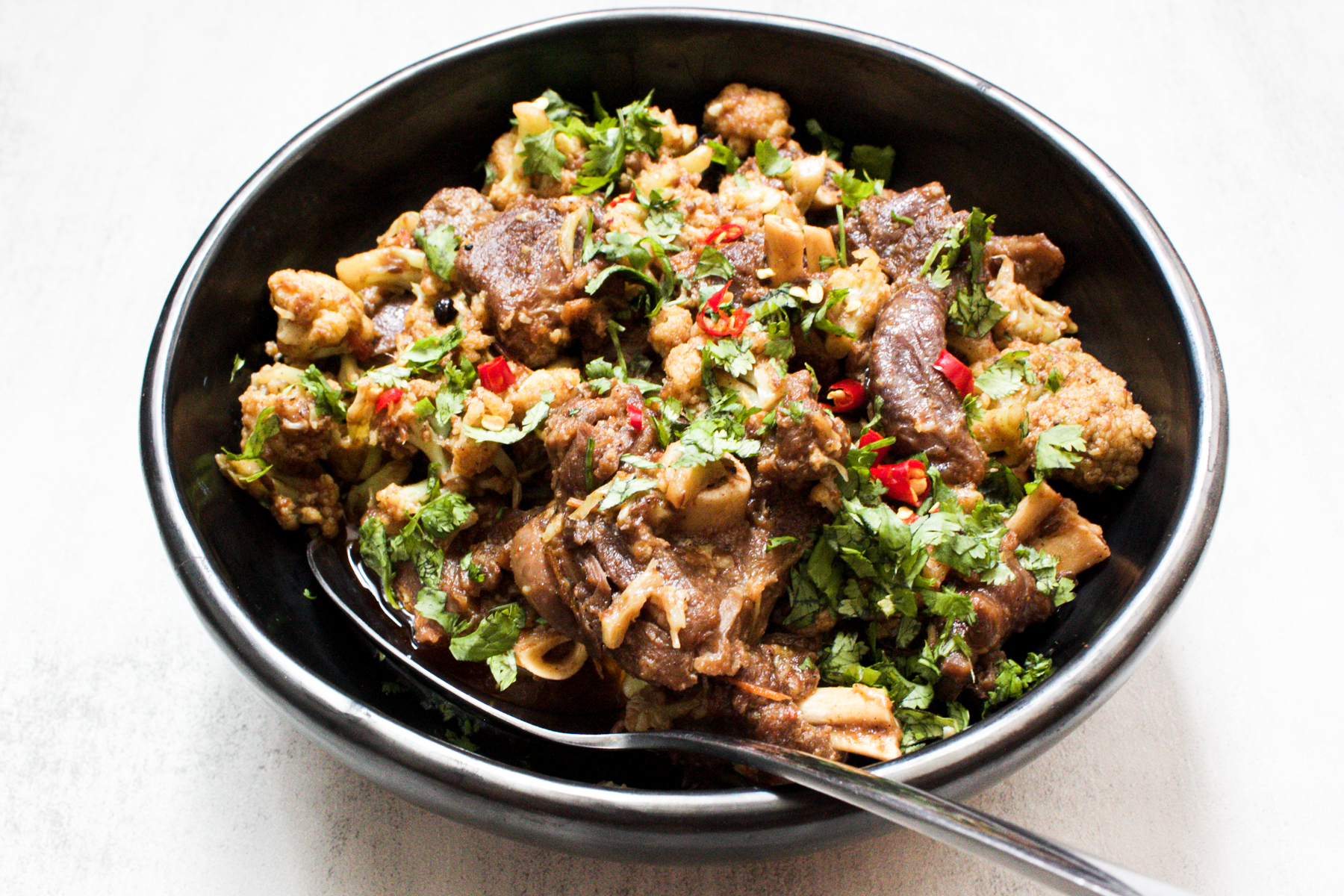
Ingredients
- Neutral oil: I used canola oil for this recipe but sunflower or vegetable oil works well too.
- Yellow or red onion: I used two small ones but adjust the quantity based on the amount of meat you have.
- Crushed ginger
- Crushed garlic
- Bird’s eye chili (optional): In Pakistan, we traditionally use bird's eye chili but you can use any fresh chili that's locally available, such as serrano and jalapeño. Just remember to adjust for heat. I find fresh chili deepens the spice level of a dish but if you want it to be on the milder side, feel free to skip.
- Goat/lamb meat: We traditionally use bone-in goat meat for this dish. But I have also prepared it using lamb, and that works too. I normally ask the butcher for shoulder cut but you can use a mixed cut as well.
- Roma or plum tomatoes
- Red chili powder: My preferred red chili powder is the Kashmiri variety found in Indian/Pakistani grocery stores but you can substitute it with cayenne red pepper. Again, remember to adjust for heat.
- Salt
- Whole cumin seeds
- Cloves: Use whole cloves for this recipe. If you don't have them, don't substitute with clove powder.
- Whole peppercorn
- Green cardamom
- Black cardamom: This is available in specialty Indian/Pakistani grocery stores. If you don't have it, don't substitute with green cardamom. Just omit it.
- Cauliflower: I used about 1 pound/500 grams of cauliflower for this recipe but it's a matter of personal preference. You can use less if you want a curry with more gravy.
- Black pepper
- Cilantro (optional)
- Garam masala powder (optional): Available at specialty Indian/Pakistani grocery stores, it provides the dish with a fun tart finish.
How to Make It
Salt Meat: Place meat in a colander and rub with salt. Set aside.
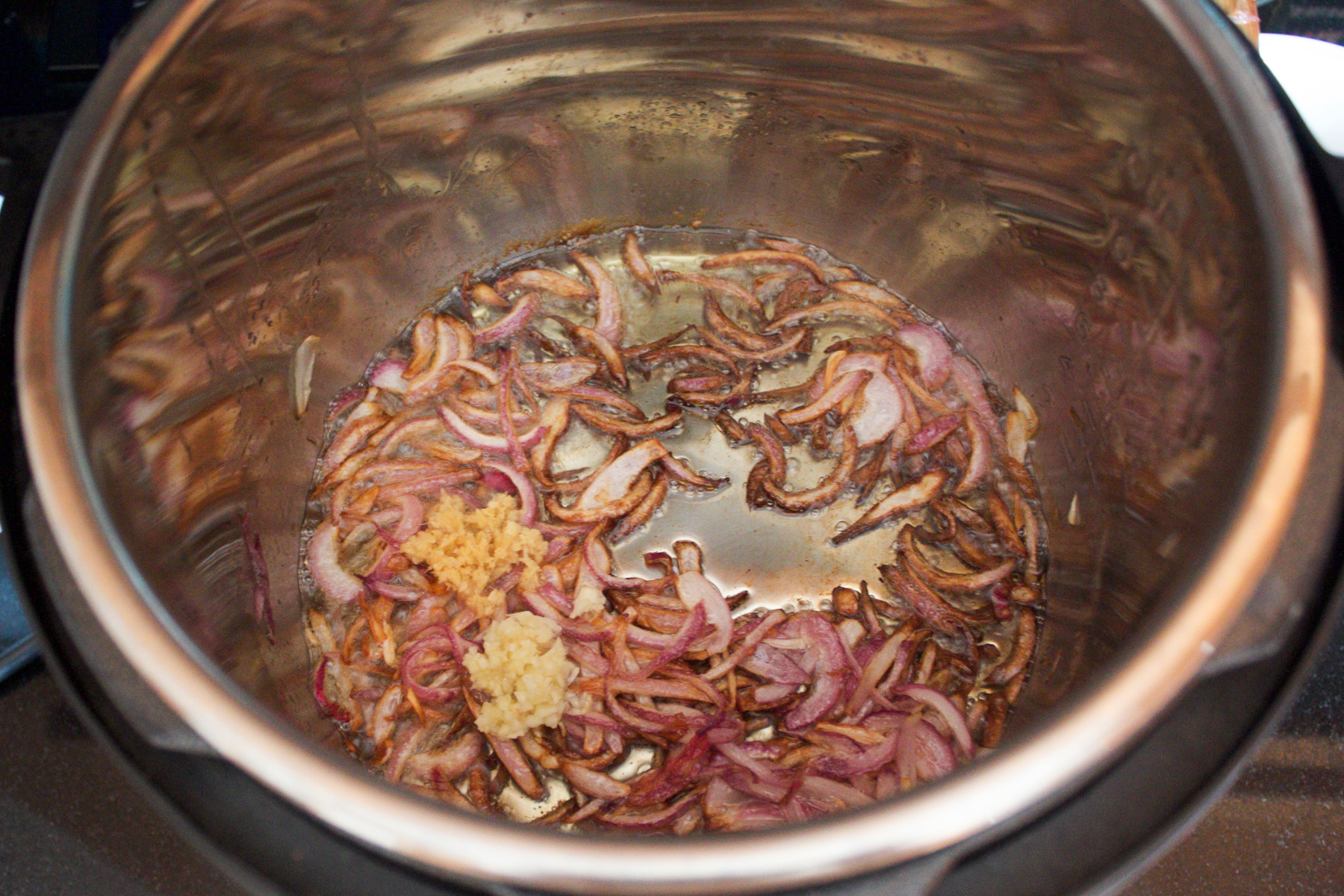
Sauté onions: Heat heavy bottom pot and add oil. Once hot, add sliced onion and sauté until evenly brown. If using Instant Pot, select ‘Sauté’. Once hot, add oil and sliced onion, and fry.
Fry crushed ginger and garlic, and chili: Add crushed ginger and garlic, and bird’s eye chili (if using). Stir until fragrant.
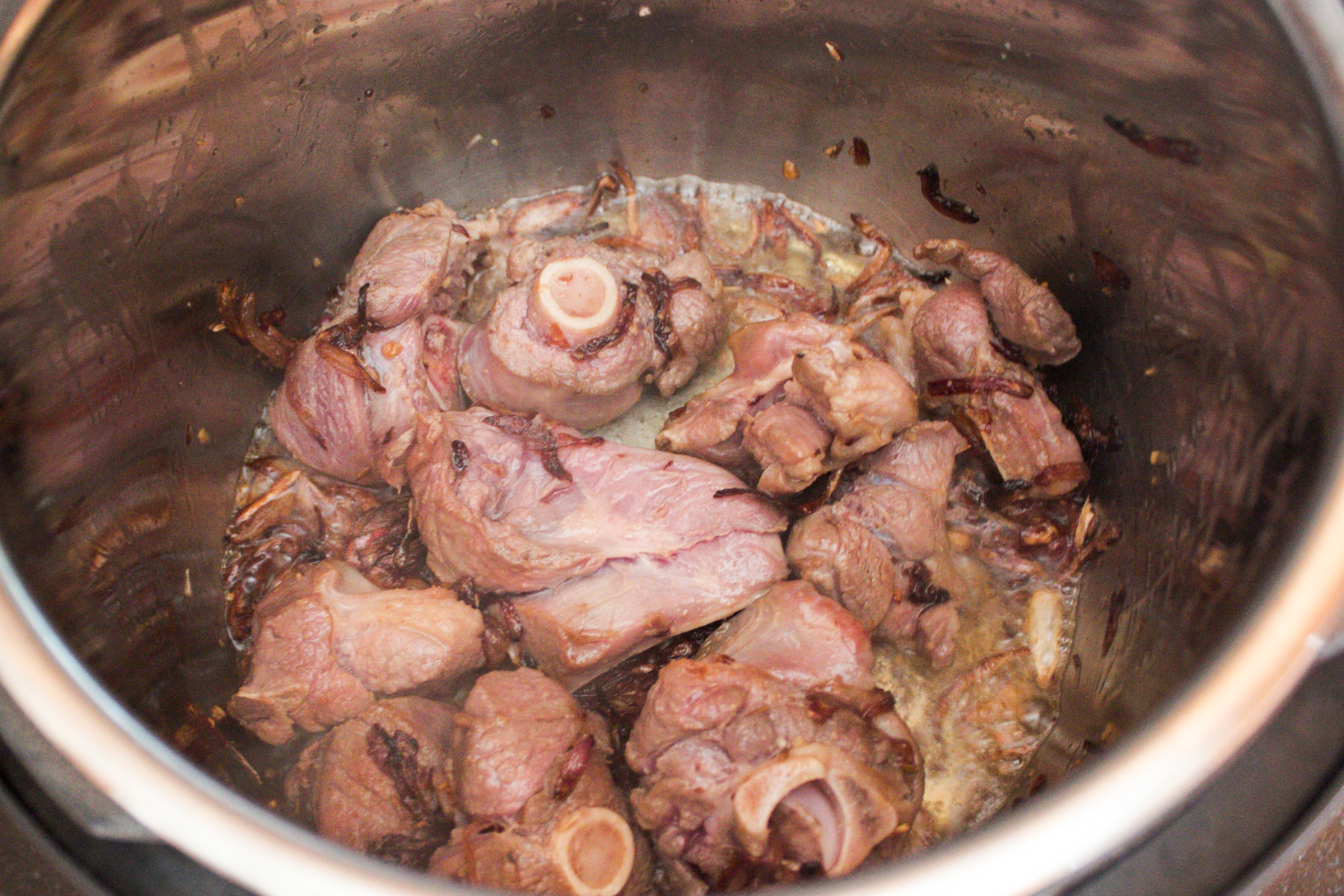
Sear meat: Add meat and stir on high heat until no longer pink.
Add tomatoes, red chili powder, salt and whole garam masala (cumin seeds, cloves, peppercorn, green and black cardamom): Stir until well-mixed.
Simmer meat until tender: Add water and bring to boil. Lower to simmer and cover. Cook until the meat is tender about 2 – 2 ½ hours. If using Instant Pot, add enough water to cover a third of the meat mixture. Cancel “Sauté” and close the lid. Move the steam valve to sealing, and on manual setting, set the cooking time to 25 minutes at high pressure. Once the timer is up, move the steam valve to venting position to immediately release steam.

Fry cauliflower: While the meat is cooking, begin to get the cauliflower ready. In a large wok or frying pan, heat remaining ¼ cup oil. Once hot, add cauliflower, salt and pepper. Sauté until just slightly brown and evenly cooked.
Add cauliflower to the meat: Once the meat is tender, carefully remove the lid and add cauliflower. Increase heat to high, and stir until the cauliflower has absorbed the masala and the oil begins to separate from the spices. If using Instant Pot, select ‘Sauté’ again and add cooked cauliflower to the meat mixture. Fry together until the oil begins to separate from the spices.
Garnish and serve: Carefully place gobi gosht into a serving bowl. Garnish with diced cilantro and chilies, and dust with garam masala powder.
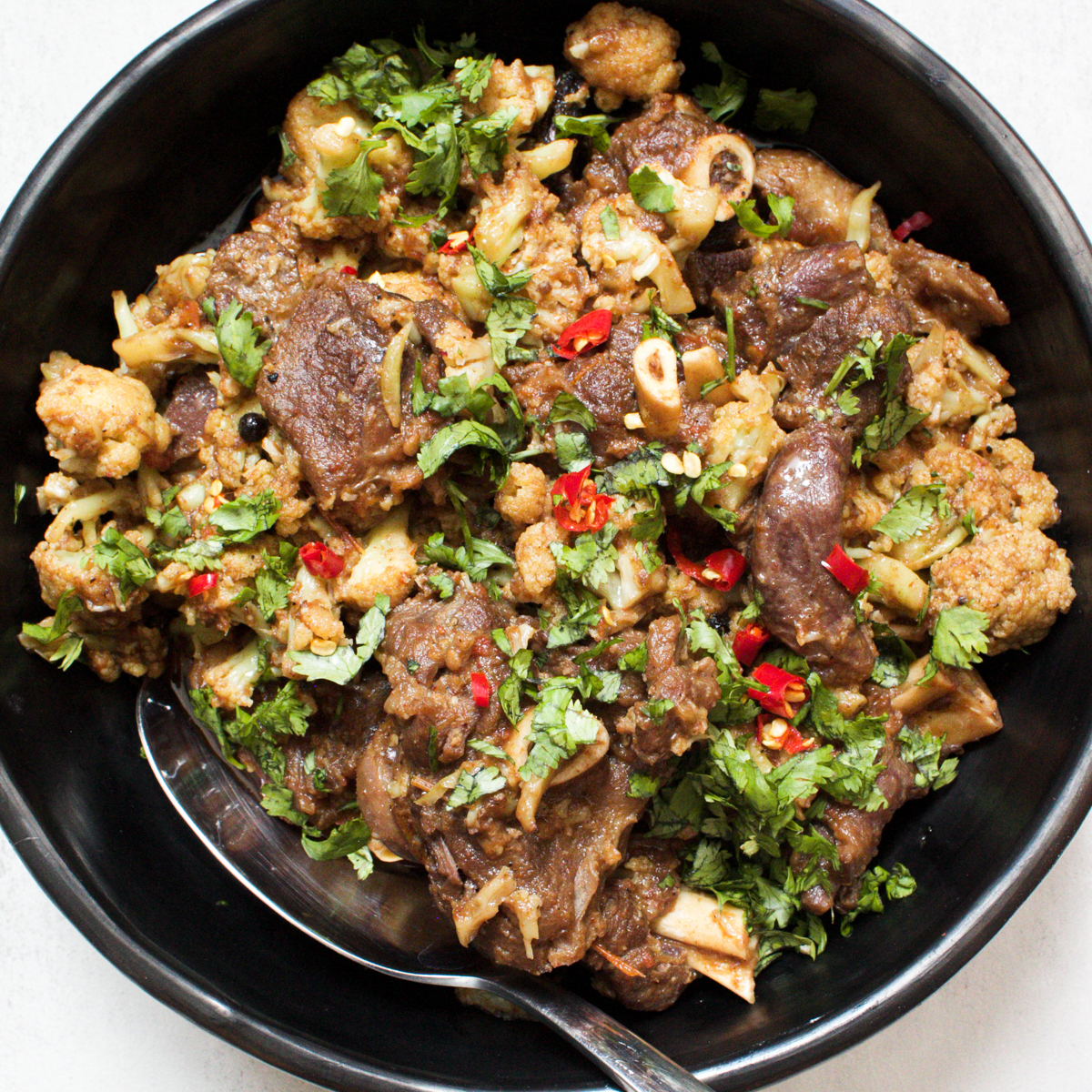
What to Serve it With
I enjoy gobi gosht with roti and and a cooling side such as raita or this simple fried cabbage.
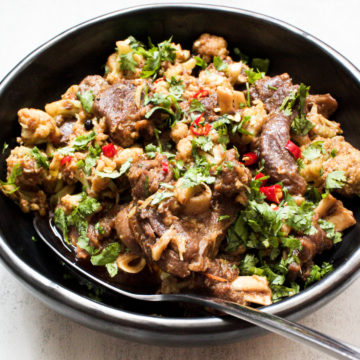
Gobi Gosht Recipe (Mutton with Cauliflower)
Equipment
- 1 Heavy bottom pot or Instant Pot
- 1 Wok or frying pan
Ingredients
- 1 pound (~500 grams) goat/lamb meat cut in small pieces
- 2½ teaspoon salt or to taste
- ¾ cup neutral oil canola, sunflower or vegetable
- 2 small (~3-5 ounces/100-150 grams) yellow or red onions thinly sliced
- 1 teaspoon crushed ginger
- 1 teaspoon crushed garlic
- 1 bird’s eye chili finely chopped, optional
- 3 (~3-5 ounces/100-150 grams) roma tomatoes diced
- 1 teaspoon red chili powder
Whole Garam Masala
- ¼ teaspoon cumin seeds
- 3 cloves
- 4 peppercorn
- 1 green cardamom
- 1 black cardamom
Cauliflower
- 1 pound (~500 grams) cauliflower cut in small florets
- 1 teaspoon salt or to taste
- ½ teaspoon black pepper or to taste
Garnish
- ½ cup cilantro finely chopped (optional)
- 2 bird’s eye chilies finely chopped (optional)
- ¼ teaspoon garam masala powder optional
Instructions
Stove Top
- Place meat in a colander and rub with 1 teaspoon of salt. Set aside.
- Heat heavy bottom pot and add ½ cup oil. Once hot, add sliced onion and sauté until evenly brown, roughly 7-10 minutes.
- Add crushed ginger and garlic, and bird’s eye chili (if using). Stir for roughly 30 seconds to 1 minute until fragrant.
- Add meat and stir on high heat until no longer pink for about 5-7 minutes.
- Add tomatoes, red chili powder, ½ teaspoon of salt and whole garam masala (cumin seeds, cloves, peppercorn, green and black cardamom). Stir until well-mixed.
- Add 2 ½ cups water and bring to boil. Lower to simmer and cover. Cook until the meat is tender about 2 – 2 ½ hours.
- While the meat is cooking, begin to get the cauliflower ready. In a large wok or frying pan, heat remaining ¼ cup oil. Once hot, add cauliflower, ½ teaspoon of salt, and pepper. Sauté until just slightly brown and evenly cooked, about 5 - 7 minutes.
- Once the meat is tender, carefully remove the lid and add cauliflower. Increase heat to high, and stir until the cauliflower has absorbed the masala and the oil begins to separate from the spices. Remove from heat.
- Carefully place gobi gosht into a serving bowl. Garnish with diced cilantro and chilies, and dust with garam masala powder.
Instant Pot
- Place meat in a colander and rub with 1 teaspoon of salt. Set aside.
- Turn Instant Pot on and select ‘Sauté’. Once hot, add ½ cup oil and sliced onion. Sauté until evenly brown, roughly 7 – 10 minutes.
- Add crushed ginger and garlic, and bird’s eye chili (if using). Stir for roughly 30 seconds to 1 minute until fragrant.
- Add meat and stir until no longer pink for about 5-7 minutes.
- Add tomatoes, red chili powder, salt and whole garam masala (cumin seeds, cloves, peppercorn, green and black cardamom). Stir until well-mixed.
- Add ½ cup water or at least enough to cover ⅓rd of the meat mixture.
- Cancel “Sauté” and close the lid. Move the steam valve to sealing, and on manual setting, set the cooking time to 25 minutes at high pressure.
- While the meat is cooking, begin to get the cauliflower ready. In a large wok or frying pan, heat remaining ¼ cup oil. Once hot, add cauliflower, salt and pepper. Sauté until just slightly brown and evenly cooked, about 5 to 7 minutes.
- Once the timer is up, move the steam valve to venting position to immediately release steam. After the pressure has released, carefully remove the lid, making sure you are not touching the metallic part.
- Select ‘Sauté’ again and add cooked cauliflower to the meat mixture. Fry until the cauliflower has absorbed the masala and the oil begins to separate from the spices.
- Turn “Instant Pot” off, and carefully place gobi gosht into a serving bowl. Garnish with diced cilantro and chilies, and dust with garam masala powder.


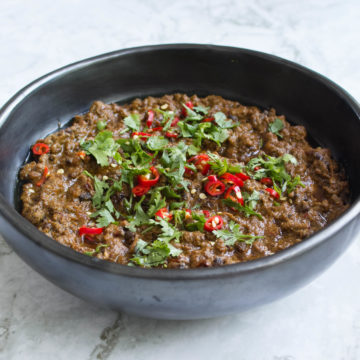
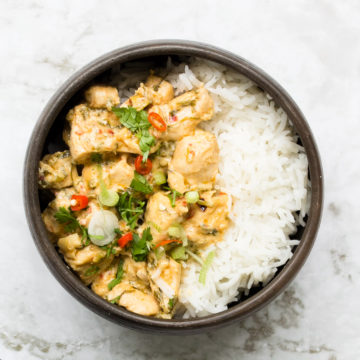
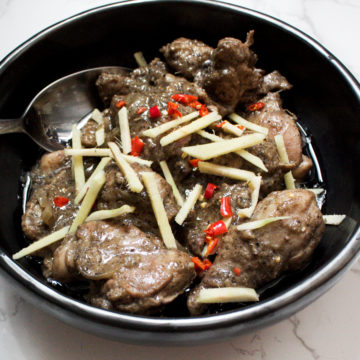
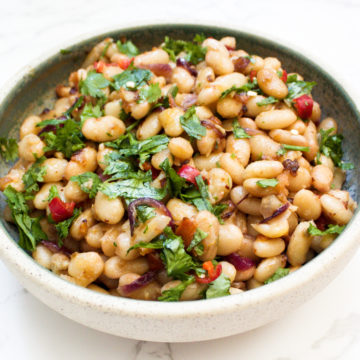
Sharjeel
This looks and tastes amazing! As Mariams brother, I can vouch for that due to my many years of experience eating it ???????
Maryam Jillani
It is a delicious recipe. Many thanks to Mariam for sharing your mom's brilliant work!
Brock
Made this yesterday, absolutely delicious flavor, I wasn't able to get my hands on some of the whole garam masala ingredients, so I just used about 2 tbsp of a ground variety with the same ingredients. Came out alittle more saucy than I thought so I doubled the cauliflower to make use of all that amazing sauce! Thank you for posting and keep up the good work I love this site!
Maryam Jillani
Brock - your comment made my day! I'm so glad you enjoyed the recipe, and thanks for the note about doubling the cauliflower.
Samina
My favorite!